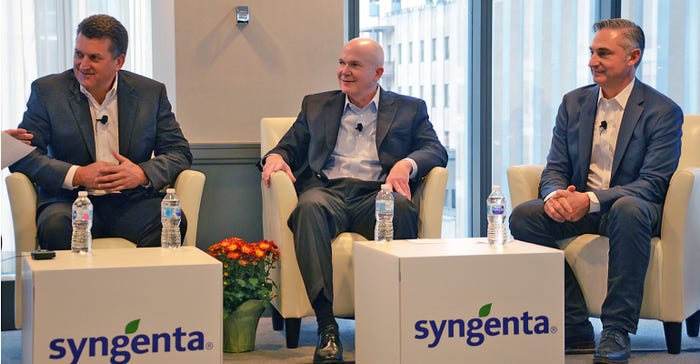November 7, 2018

Agriculture is in a state of change, perhaps greater than at any recent time in history. The key trends driving this industry are reshaping how many farmers look at their businesses; and while it can offer opportunity, change brings challenges, too. For the Syngenta leadership team, pushing ahead in this environment brings new opportunities for the business, and customers.
A panel of Syngenta leaders spoke recently at a company media event which has been held every other year for more than a decade. At this year’s event, David Hollinrake, president, Syngenta Seeds; Vern Hawkins, president, Syngenta Crop Protection; and Trevor Heck, president, Syngenta Canada, shared their insights on market forces at work in the industry in a panel presentation.
Some key takeaways from their conversation are that farmers are inundated with information they want to make sense of; soft prices make it hard to be strategic; and when tools provide a solid return on investment, farmers will buy.

LEADERS SPEAK: The Syngenta leadership team spoke during a recent panel discussion, talking about the current ag market and the future: Vern Hawkins (left), president, Syngenta Crop Protection; David Hollinrake, president, Syngenta Seeds; and Trevor Heck, president, Syngenta Canada.

Tech remains key
Technology was top of mind for the conference, which carried a “new era” theme throughout. In this leadership panel, Hollinrake noted that in today’s agriculture, there are experts at work that you wouldn’t have thought about a decade ago: From computational biologists to genomicists to molecular biologists, the industry is changing. “To the farm, this is a step change for decision-making and yield,” Hollinrake said.
Added Hawkins: “The amount of variables we can analyze to contribute to decision-making has changed in the last decade.”
As for digital farming? Hollinrake acknowledged that farmers are overwhelmed by the technology, and Syngenta wants to be part of the solution. With its AgriEdge Excelsior platform and investment in Land.db, the company has created a profit-planning program farmers can use to pull everything together.
“Farmers are not challenged with having digital capabilities. They have several platforms they’re using but they want to have them speak to one another, to get the APIs to interact. That’s a role we could and will play to enable that information to be utilized,” Hollinrake said. “The return-on-investment-savvy farmer has years of data, and they want a tool they can trust and people they can trust to help them make a real-time decision.”
Note: An API is an application program interface, and it’s how different systems share information for improved decision-making.
Farmers invest for returns
All the panelists acknowledged that the current ag market is soft, with low prices making investment and strategic planning difficult. However, Hawkins said that conversations on the farm are more focused on return on investment, and farmers have access to more information about their businesses thanks to the precision systems they use.
“Farmers are using that information to make a decision about what they use, what research they have to take a little more income out of each acre,” he said. And they’ll invest in new tools if they see value.”
Hawkins pointed to Trivapro fungicide, a premium-priced product with three active ingredients that has seen the fastest growth of any product in Syngenta’s line. “[The farmer] sees an enhanced return on investment, and they have sufficient capital to step in with acres and still make those investments. But they’ll be more selective.”
Trevor Heck shared that Canadian producers are also engaging technology, and they’re adding more crops to their farms with soybeans, canola and other crops increasing in acreage. “We need more crop opportunities, with new crops for new markets. [In Canada], we’re a big exporter of crops, and farmers want more options,” he said.
Beyond involvement in digital farming, Syngenta is hard at work on new tools for both seed and crop protection for the future. Hawkins said the company registered three new active ingredients in 2015. He pointed out Miravis fungicide, which offers a new mode of action to the market and will help with resistance. “We have a pipeline that will back up the need for new controls, and I feel good about the innovation curve we’re on,” he said.
Future may be 'stacked'
For Hollinrake — who is focused on seed and driving a significant move to build market share with a revitalized Golden Harvest brand, and an emphasis on the retail side for NK — the future may be “stacked.”
“What the farmer is asking for is a multistack trait that provides the ultimate choice for herbicide technology to use,” he said. Enhancing crops with added traits for more flexibility is a driver for future development.
Add in the company focus on digital farming and tools that can help pull information into a single place for decision-making, and Syngenta is staking its claim as a leader in a changed crop protection and seed market, where mergers and acquisitions have reshaped the landscape. Stay tuned.
About the Author(s)
You May Also Like






